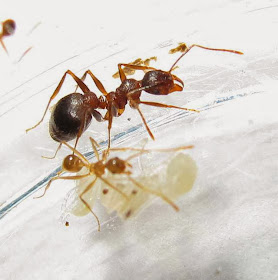Most species of the Pheidole genus are dimorphic and it has been reported that less than one percent of this vast genus is trimorphic. There are six or seven known species of Pheidole that are trimorphic and these are mostly found in North America. All these known trimorphic species have two major worker expression namely the major and super major.
In this very rare trimorphic species there are three morphological expression of the worker's caste. But most unusual is that beside the typical minor and major workers expression there is a median worker expression. The major workers are characterized by large gaster that are approximately the same size as their heads. This disproportionately large gaster is also in the median worker.
The minor, median and major workers with a gyne and brood of a rare trimorphic species of Pheidole sp(24) ant.
The minor, median and major workers with a gyne and brood of a rare trimorphic species of Pheidole ant.
The minor, median and major workers with a gyne and brood of a rare trimorphic species of Pheidole ant.
The minor, median and major workers with a gyne and brood of a rare trimorphic species of Pheidole ant.
The minor and major workers with a gyne and brood of a rare trimorphic species of Pheidole ant.
The minor and major workers with a gyne and brood of a rare trimorphic species of Pheidole ant.
The minor and major workers with a gyne and brood of a rare trimorphic species of Pheidole ant.
The queen with major and minor workers and brood of a rare trimorphic species of Pheidole ant.
The minor and major workers with a gyne and brood of a rare trimorphic species of Pheidole ant.
The major workers of this rare Pheidole species.
The major and minor workers of this rare Pheidole species.
The major, median and minor workers of this rare Pheidole species.
The median, minor and major workers of this rare Pheidole species.
The median, minor and major workers of this rare Pheidole species.
The median and minor workers of this rare Pheidole species with pupae (of minor and median workers).
The median and minor workers of this rare Pheidole species with pupae (of minor and median workers).
The median worker of a rare trimorphic Pheidole ant species.
The median and minor workers of this rare Pheidole species with pupae (of minor and median workers) and a larva.
The minor worker of this trimorphic Pheidole ant.
The minor, median and major workers with a gyne and brood of a rare trimorphic species of Pheidole ant.
The minor, median and major workers with a gyne and brood of a rare trimorphic species of Pheidole ant.
The minor, median and major workers with a gyne and brood of a rare trimorphic species of Pheidole ant.
The minor and major workers with a gyne and brood of a rare trimorphic species of Pheidole ant.
The minor and major workers with a gyne and brood of a rare trimorphic species of Pheidole ant.
The minor and major workers with a gyne and brood of a rare trimorphic species of Pheidole ant.
The queen with major and minor workers and brood of a rare trimorphic species of Pheidole ant.
The minor and major workers with a gyne and brood of a rare trimorphic species of Pheidole ant.
The major workers of this rare Pheidole species.
The major and minor workers of this rare Pheidole species.
The major, median and minor workers of this rare Pheidole species.
The median, minor and major workers of this rare Pheidole species.
The median, minor and major workers of this rare Pheidole species.
The median and minor workers of this rare Pheidole species with pupae (of minor and median workers).
The median and minor workers of this rare Pheidole species with pupae (of minor and median workers).
The median worker of a rare trimorphic Pheidole ant species.
The median and minor workers of this rare Pheidole species with pupae (of minor and median workers) and a larva.
The minor worker of this trimorphic Pheidole ant.
See also:
Updated: 2022 03 15
First Posted: 2014 04 08
Taxonomy:
No rank: cellular organisms 131567
Superkingdom (Domain): Eukaryota 2759
No rank: Opisthokonta 33154
Kingdom: Metazoa 33208
No rank: Eumetazoa 6072
No rank (Subkingdom): Bilateria 33213
No rank (Branch): Protostomia 33317
No rank (Infrakingdom): Ecdysozoa
No rank (Superphylum): Panarthropoda 88770
Phylum: Arthropoda 6656
No rank (Subphylum): Mandibulata 197563
No rank: Pancrustacea 197562
Subphylum (Epiclass): Hexapoda 6960
Class: Insecta 50557
No rank (Subclass): Dicondylia 85512
Subclass (Infraclass): Pterygota 7496
Infraclass: Neoptera 33340
Cohort: Holometabola
Order: Hymenoptera 7399
Suborder Apocrita 7400
Infraorder: Aculeata 7434
Superfamily: Formicoidea
Family: Formicidae 36668
Subfamily: Myrmicinae 34695
Tribe: Pheidolini 144015
Genus: Pheidole 190769
© 2009 – 2022 Quah. All rights reserved.



















No comments:
Post a Comment
Sorry Guys, Google Chrome or Blogger bugs prevent me from replying to comments again. It keeps telling me to sign in (even though I am always sign in) but when I click to sign in, it tells me "Unable to sign in check Google profile'. So sorry I can't reply to your comments.
Alternatively you can sent me an email if you are in need of answers.
Note: Only a member of this blog may post a comment.